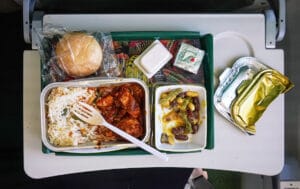
It was through a New York City allergist that I heard about Skylar’s story of a frightening food allergy reaction at 35,000 feet over the Atlantic Ocean. The young medical research volunteer had taken an airline’s meal in May 2023 on a flight from New York City to Copenhagen.
After completing her senior year of college, Skylar was excited to fly off to visit a friend in Denmark. What she didn’t appreciate: food allergy labeling in the air is not what it is on the ground.
Skylar told me she had made the crew on this Delta Airlines flight aware of her tree nut and peanut allergies. When it came time for the meal service, she chose the pasta with pesto – the only selection that bore a label with allergen information.
She had a nagging concern that pesto could contain nuts. But as the allergen information on the packaging only listed milk, wheat, and soy as allergens, Skylar felt safe in her choice. As well, she was served a caprese salad and bread, and says a flight attendant assured her they didn’t contain nuts.
Yet 15 minutes after eating, Skylar felt her throat begin to tighten and the constriction continued. Concerned, she took two antihistamine tablets and pressed the call button. She asked the main flight attendant to see allergen lists for what she ate, worried that nuts might have been in her meal.
She subsequently went to the restroom and vomited three times in a row.
After an hour, a different attendant finally said there was no ingredient information on board. She could not confirm whether Skylar had consumed nuts.
Airline Meals and Allergy Labels
As her symptoms were gradually subsiding, Skylar decided she didn’t need to use her Auvi-Q epinephrine injector.
But the question remains for Skylar and many passengers: are food allergy labels on airline meals accurate? Are they even required to be?
As the leading food allergy airline advocate and founder of the nonprofit No Nut Traveler, I’ve heard many concerns about airline meals and allergen transparency. Some testimonials I’ve collected include food allergy reactions to airline meals that passengers believed to be safe. Many followers also ask about the availability of ingredient lists for meals.
As airline meals have been a gray area of food allergen labeling, Allergic Living asked me to investigate the rules, in my role as their airlines correspondent. I reached out to the U.S. Food and Drug Administration (FDA). The agency’s answers were concerning.
A spokesperson explained that the FDA’s purview as the U.S. regulator of allergen food labeling does extend to airlines under the Federal Food, Drug, and Cosmetic Act (FD&C).
But the catch is, to fall under the regulations, the food has to be “prepackaged”. This means that the packaged snack like cookies or potato chips you receive on an airline is subject to labeling requirements for top allergens.
But what about the in-flight meal? Is that considered “prepackaged”? In some cases they do have wrapping and ingredient listings.
According to the FDA spokesperson, not all food served on airlines is considered packaged food. If the food is served ‘restaurant-style’ and either uncovered or not sealed into a package, labeling is not currently required on that food.
So in short, the FDA treats in-flight meals served on airlines in the same vein as restaurant food. Restaurants in the United States remain exempt from required food allergen labeling.
Airline Meals: What to Know
I mentioned to the FDA that airline meals are planned in advance, so couldn’t there at least be ingredient lists?
The spokesperson expanded on the point that this isn’t required, except when foods are packaged. But she did note: “While there are not ingredient or allergen labeling requirements for these restaurant-style meals, we would strongly encourage this information be available due to potential allergen issues.”
When it comes to precautionary or “may contain” warnings, as with packaged foods on land, those aren’t required, but can be added at the supplier’s discretion.
The takeaway here is that it’s critical to understand there is no legal requirement for airline catering companies to label in-flight restaurant-style meals. So, while the FDA encourages the information be available, there’s also no obligation for airlines or their caterers to provide thorough ingredient lists.
What’s deeply concerning to me and to Allergic Living is not just the lack of labeling. It’s also the lack of communication around food labels on airlines. Consider the unsuspecting allergy passenger who sees an ingredients list on an in-flight meal. It’s unlikely they will know this list is not subject to the same strict allergen labeling requirements as packaged food at the grocery store. The result? They may unknowingly eat food with their allergen.
Vegan, Gluten-Free Meals
I asked as well about airline meals labeled as gluten-free or vegan. These are now commonly served. The FDA told me that, “airline foods that are served packaged to the passenger must meet all other applicable labeling requirements for packaged food, which would include meeting the gluten-free requirements and providing truthful and non-misleading information with respect to any vegan labeling statements.” Again, the term “packaged” is key.
When I asked about vegan meals specifically, the spokesperson said “the term ‘vegan’ is not regulated by the FDA.” She said the agency does, however, weigh whether a claim is false or misleading. The FDA evaluates vegan label claims on a “case-by-case basis in the context of the entire label.”
What I take from such statements is that a person with a dairy allergy or intolerance should not rely on a vegan label on an airline meal. (Unless it’s prepackaged.)
For now, it would be my recommendation not to accept any airline meal with a food allergy, celiac disease or a food intolerance. I’ve previously reported that airline staff are not required to be trained in food allergies. And now we become aware that ingredient lists are not required to be available for restaurant-style airline meals.
Knowledge is power. It’s a simple risk vs. reward equation. Bring safe food to eat on the flight. No matter how hungry you are, no meal up in the air is worth an allergic reaction.
Skylar is far from the only person to accept an in-flight meal and assume the label was an ingredients list. Many people have had labeling snafus with in-flight meals, including those who request gluten-free, nut-free, or vegan options.
Ingredient Confusion in the Skies
Consider the testimonial shared on my website by the mother of a young toddler with a nut allergy. She says that at the meal service on a United Airlines flight, she had asked the flight attendant whether either the pasta or chicken had nuts. She was assured they didn’t. Her daughter had the pasta, but the mom also shared with her child the rice from her chicken dish.
She told me that the label on the chicken said, “Buttery Chicken.” It did not have an ingredient list or any allergy warnings. A severe allergic reaction ensued that thankfully resolved.
In another case, a mother ordered a presumed allergy-friendly meal for a child with a nut allergy. The child’s mother asked the flight attendant if the unlabeled chocolate that came with the meal was safe. She says the flight attendant “went over some paperwork and assured me it was safe.” Her son ate the chocolate and as she puts it “the nightmare began.” An auto-injector was used, and medical staff were waiting for them as the plane landed.
I recently kept a Tweet from a woman named Alison, who tagged Delta Airlines while on a flight from Honolulu to Los Angeles. She wrote,”My vegan meal contained egg, butter, and dairy yoghurt. Husband’s meal was the same. He has dairy allergy. Do better.”
What to Do After a Reaction
Also worth knowing: is there an avenue for a passenger to file a report if there’s a reaction to an airline’s meal after airline assurances it would be safe? The FDA spokesperson says consumers should report product reactions or labeling concerns through the Consumer Complaint Coordinator in their home state.
Passengers can also call FDA at 1-888-SafeFood for any food-related questions under FDA’s jurisdiction. Or they can report suspected adverse events using FDA’s MedWatch online reporting forms. They also encourage the passenger to contact the airline to share any concerns.
For her part, Skylar learned the hard way not to accept an airline meal, but we must get the message out to all passengers with food allergies. It’s important to note that many patients are not informed by their doctors to avoid airline meals. Travel is often not discussed in time-limited appointments, and doctors may not be aware that ingredients of in-flight meals, when listed, are not subject to labeling requirements.
With limited access to medical care on a flight, it’s vital to pack your own meal or snack to stay safe in the air!
Lianne Mandelbaum is Allergic Living’s airlines correspondent, and the founder of NoNutTraveler.com.
Related Reading:
Nuts on Planes: from Jack Fowler’s Scare to Flying with Snickers
FDA Guidance Calls for Allergen Labels for Dining, Delis
How to Read a Label When You Have Food Allergies
Anaphylaxis Over the Ocean, With No Epinephrine Vial





